
John Michael Wright
Encyclopedia
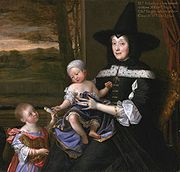
Portrait
thumb|250px|right|Portrait of [[Thomas Jefferson]] by [[Rembrandt Peale]], 1805. [[New-York Historical Society]].A portrait is a painting, photograph, sculpture, or other artistic representation of a person, in which the face and its expression is predominant. The intent is to display the likeness,...
in the Baroque
Baroque
The Baroque is a period and the style that used exaggerated motion and clear, easily interpreted detail to produce drama, tension, exuberance, and grandeur in sculpture, painting, literature, dance, and music...
style. Described variously as English and Scottish, Wright trained in Edinburgh under the Scots
Scotland
Scotland is a country that is part of the United Kingdom. Occupying the northern third of the island of Great Britain, it shares a border with England to the south and is bounded by the North Sea to the east, the Atlantic Ocean to the north and west, and the North Channel and Irish Sea to the...
painter George Jamesone, and acquired a considerable reputation as an artist and scholar during a long sojourn in Rome
Rome
Rome is the capital of Italy and the country's largest and most populated city and comune, with over 2.7 million residents in . The city is located in the central-western portion of the Italian Peninsula, on the Tiber River within the Lazio region of Italy.Rome's history spans two and a half...
. There he was admitted to the Accademia di San Luca
Accademia di San Luca
The Accademia di San Luca, was founded in 1577 as an association of artists in Rome, under the directorship of Federico Zuccari, with the purpose of elevating the work of "artists", which included painters, sculptors and architects, above that of mere craftsmen. Other founders included Girolamo...
, and was associated with some of the leading artists of his generation. He was engaged by Archduke Leopold Wilhelm of Austria
Archduke Leopold Wilhelm of Austria
Archduke Leopold Wilhelm of Austria was an Austrian military commander, Governor of the Spanish Netherlands from 1647 to 1656, and a patron of the arts.-Biography:...
, the governor of the Spanish Netherlands, to acquire artworks in Oliver Cromwell's
Oliver Cromwell
Oliver Cromwell was an English military and political leader who overthrew the English monarchy and temporarily turned England into a republican Commonwealth, and served as Lord Protector of England, Scotland, and Ireland....
England in 1655. He took up permanent residence in England from 1656, and served as court painter
Court painter
A court painter was an artist who painted for the members of a royal or noble family, sometimes on a fixed salary and on an exclusive basis where the artist was not supposed to undertake other work. Especially in the late Middle Ages, they were often given the office of valet de chambre...
before and after the English Restoration
English Restoration
The Restoration of the English monarchy began in 1660 when the English, Scottish and Irish monarchies were all restored under Charles II after the Interregnum that followed the Wars of the Three Kingdoms...
. A convert to Roman Catholicism, he was a favourite of the restored Stuart
House of Stuart
The House of Stuart is a European royal house. Founded by Robert II of Scotland, the Stewarts first became monarchs of the Kingdom of Scotland during the late 14th century, and subsequently held the position of the Kings of Great Britain and Ireland...
court, a client of both Charles II
Charles II of England
Charles II was monarch of the three kingdoms of England, Scotland, and Ireland.Charles II's father, King Charles I, was executed at Whitehall on 30 January 1649, at the climax of the English Civil War...
and James II
James II of England
James II & VII was King of England and King of Ireland as James II and King of Scotland as James VII, from 6 February 1685. He was the last Catholic monarch to reign over the Kingdoms of England, Scotland, and Ireland...
, and was a witness to many of the political maneuverings of the era. In the final years of the Stuart monarchy he returned to Rome as part of an embassy to Pope Innocent XI
Pope Innocent XI
Blessed Pope Innocent XI , born Benedetto Odescalchi, was Pope from 1676 to 1689.-Early life:Benedetto Odescalchi was born at Como in 1611 , the son of a Como nobleman, Livio Odescalchi, and Paola Castelli Giovanelli from Gandino...
.
Wright is currently rated as one of the leading indigenous British painters of his generation, largely for the distinctive realism
Realism (visual arts)
Realism in the visual arts is a style that depicts the actuality of what the eyes can see. The term is used in different senses in art history; it may mean the same as illusionism, the representation of subjects with visual mimesis or verisimilitude, or may mean an emphasis on the actuality of...
in his portraiture. Perhaps due to the unusually cosmopolitan nature of his experience, he was favoured by patrons at the highest level of society in an age in which foreign artists were usually preferred. Wright's paintings of royalty and aristocracy are included amongst the collections of many leading galleries today.
Early years and Scottish connections
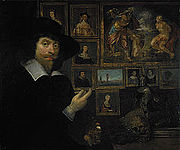
John Evelyn
John Evelyn was an English writer, gardener and diarist.Evelyn's diaries or Memoirs are largely contemporaneous with those of the other noted diarist of the time, Samuel Pepys, and cast considerable light on the art, culture and politics of the time John Evelyn (31 October 1620 – 27 February...
called him a Scotsman, an epithet repeated by Horace Walpole
Horace Walpole, 4th Earl of Orford
Horatio Walpole, 4th Earl of Orford was an English art historian, man of letters, antiquarian and Whig politician. He is now largely remembered for Strawberry Hill, the home he built in Twickenham, south-west London where he revived the Gothic style some decades before his Victorian successors,...
and tentatively accepted by his later biographer, Verne. However, writing in 1700, the English antiquarian Thomas Hearne
Thomas Hearne
Thomas Hearne or Hearn , English antiquary, was born at Littlefield Green in the parish of White Waltham, Berkshire.-Life:...
claims Wright was born in Shoe Lane, London
London
London is the capital city of :England and the :United Kingdom, the largest metropolitan area in the United Kingdom, and the largest urban zone in the European Union by most measures. Located on the River Thames, London has been a major settlement for two millennia, its history going back to its...
and, after an adolescent conversion to Roman Catholicism, was taken to Scotland by a priest. A London birth certainly seems supported by a baptismal record, dated May 25, 1617, for a "Mighell Wryghtt", son of James Wright, described as a tailor and a citizen of London, in St Bride's Church
St Bride's Church
St Bride's Church is a church in the City of London, England. The building's most recent incarnation was designed by Sir Christopher Wren in 1672 on Fleet Street in the City of London, though Wren's original building was largely gutted by fire during the London Blitz in 1940. Due to its location on...
, Fleet Street
Fleet Street
Fleet Street is a street in central London, United Kingdom, named after the River Fleet, a stream that now flows underground. It was the home of the British press until the 1980s...
, London.
What is known is that, on April 6, 1636, the 19-year-old Wright was apprenticed to George Jamesone, an Edinburgh
Edinburgh
Edinburgh is the capital city of Scotland, the second largest city in Scotland, and the eighth most populous in the United Kingdom. The City of Edinburgh Council governs one of Scotland's 32 local government council areas. The council area includes urban Edinburgh and a rural area...
portrait painter of some repute. The Edinburgh Register of Apprentices records him as "Michaell, son to James W(right), tailor, citizen of London". The reasons for this move to Scotland
Scotland
Scotland is a country that is part of the United Kingdom. Occupying the northern third of the island of Great Britain, it shares a border with England to the south and is bounded by the North Sea to the east, the Atlantic Ocean to the north and west, and the North Channel and Irish Sea to the...
are unclear, but may have to do with familial connections (his parents may have been London Scots) or the advent of plague in London. During his apprenticeship, Wright is likely to have lodged at the High Street
Royal Mile
The Royal Mile is a succession of streets which form the main thoroughfare of the Old Town of the city of Edinburgh in Scotland.As the name suggests, the Royal Mile is approximately one Scots mile long, and runs between two foci of history in Scotland, from Edinburgh Castle at the top of the Castle...
tenement near the Netherbow Gate that served as Jameson's workplace. The apprenticeship was contracted for five years, but may have been curtailed by Jameson's imprisonment in late 1639. There is no record of any independent work by Wright from this period (his earliest known painting being a small portrait of Robert Bruce, 1st Earl of Ailesbury
Robert Bruce, 1st Earl of Ailesbury
Robert Bruce, 1st Earl of Ailesbury and 2nd Earl of Elgin, PC, FRS was the son of Thomas Bruce, 1st Earl of Elgin....
, painted in the early 1640s during his time in Rome).
It is also possible that Wright met his wife during his Scottish residency. Nothing is known of her, except from a statement of thirty years later which describes her as "related to the most noble and distinguished families of Scotland." If this is accurate, it may explain how Wright was later able to find aristocratic patronage. All that is known for certain is that Wright had at least one child by her, a son, Thomas.
Rome and the Netherlands
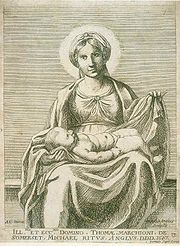
Accademia di San Luca
The Accademia di San Luca, was founded in 1577 as an association of artists in Rome, under the directorship of Federico Zuccari, with the purpose of elevating the work of "artists", which included painters, sculptors and architects, above that of mere craftsmen. Other founders included Girolamo...
(where he is recorded as "Michele Rita, pittore inglese"). At that time, the Accademia included numbers of established Italian painters as well as illustrious foreigners including the French Nicolas Poussin
Nicolas Poussin
Nicolas Poussin was a French painter in the classical style. His work predominantly features clarity, logic, and order, and favors line over color. His work serves as an alternative to the dominant Baroque style of the 17th century...
and Spaniard Diego Velázquez
Diego Velázquez
Diego Rodríguez de Silva y Velázquez was a Spanish painter who was the leading artist in the court of King Philip IV. He was an individualistic artist of the contemporary Baroque period, important as a portrait artist...
. On February 10 of that same year he was elected to the Congregazione dei Virtuosi al Pantheon, a charitable body promoting the Roman Catholic faith through art, which hosted an annual exhibition in the Pantheon
Pantheon, Rome
The Pantheon ,Rarely Pantheum. This appears in Pliny's Natural History in describing this edifice: Agrippae Pantheum decoravit Diogenes Atheniensis; in columnis templi eius Caryatides probantur inter pauca operum, sicut in fastigio posita signa, sed propter altitudinem loci minus celebrata.from ,...
.
Wright was to spend more than ten years in Rome. During that time became an accomplished linguist as well as an established art connoisseur. He also became prosperous enough to build up a substantial collection of books, prints, paintings, gems and medals, including works attributed to Mantegna
Andrea Mantegna
Andrea Mantegna was an Italian painter, a student of Roman archeology, and son in law of Jacopo Bellini. Like other artists of the time, Mantegna experimented with perspective, e.g., by lowering the horizon in order to create a sense of greater monumentality...
, Michelangelo
Michelangelo
Michelangelo di Lodovico Buonarroti Simoni , commonly known as Michelangelo, was an Italian Renaissance painter, sculptor, architect, poet, and engineer who exerted an unparalleled influence on the development of Western art...
, Raphael
Raphael
Raffaello Sanzio da Urbino , better known simply as Raphael, was an Italian painter and architect of the High Renaissance. His work is admired for its clarity of form and ease of composition and for its visual achievement of the Neoplatonic ideal of human grandeur...
, Titian
Titian
Tiziano Vecelli or Tiziano Vecellio Tiziano Vecelli or Tiziano Vecellio Tiziano Vecelli or Tiziano Vecellio (c. 1488/1490 – 27 August 1576 better known as Titian was an Italian painter, the most important member of the 16th-century Venetian school. He was born in Pieve di Cadore, near...
and Correggio. He acquired some forty paintings – perhaps as much through dealing as collecting. Richard Symonds
Richard Symonds (diarist)
Richard Symonds was an English royalist and antiquary, now remembered for an eye-witness diary he wrote of events of the First English Civil War.-Life:...
, the amateur painter and royalist, catalogued Wright's collection in the early 1650s (and interestingly designated him as "Scotus").
Antiquarian for Leopold of Austria
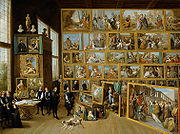
Brussels
Brussels , officially the Brussels Region or Brussels-Capital Region , is the capital of Belgium and the de facto capital of the European Union...
where his abilities were recognised by Archduke Leopold Wilhelm of Austria
Archduke Leopold Wilhelm of Austria
Archduke Leopold Wilhelm of Austria was an Austrian military commander, Governor of the Spanish Netherlands from 1647 to 1656, and a patron of the arts.-Biography:...
then governor of the Spanish Netherlands. Leopold employed him not as an artist, but as an advisor on antiquities. As the younger brother of the Emperor Ferdinand III
Ferdinand III, Holy Roman Emperor
Ferdinand III was Holy Roman Emperor from 15 February 1637 until his death, as well as King of Hungary and Croatia, King of Bohemia and Archduke of Austria.-Life:...
and cousin of Philip IV of Spain
Philip IV of Spain
Philip IV was King of Spain between 1621 and 1665, sovereign of the Spanish Netherlands, and King of Portugal until 1640...
, the Archduke had the wherewithal to amass a large collection of paintings and antiquities. Moreover, in the spring of 1655, the Archduke was enjoying a period of cordial relations with Oliver Cromwell
Oliver Cromwell
Oliver Cromwell was an English military and political leader who overthrew the English monarchy and temporarily turned England into a republican Commonwealth, and served as Lord Protector of England, Scotland, and Ireland....
, then Lord Protector
The Protectorate
In British history, the Protectorate was the period 1653–1659 during which the Commonwealth of England was governed by a Lord Protector.-Background:...
of England. (Indeed the two had been exchanging gifts of horses, and Leopold had provided Cromwell with choice tapestries and other artefacts for the refurbishment of the Palace of Whitehall
Palace of Whitehall
The Palace of Whitehall was the main residence of the English monarchs in London from 1530 until 1698 when all except Inigo Jones's 1622 Banqueting House was destroyed by fire...
. Cromwell also received an embassy from the Habsburgs congratulating him on his new office.) Since the execution of Charles I
Charles I of England
Charles I was King of England, King of Scotland, and King of Ireland from 27 March 1625 until his execution in 1649. Charles engaged in a struggle for power with the Parliament of England, attempting to obtain royal revenue whilst Parliament sought to curb his Royal prerogative which Charles...
in 1649, Leopold had been purchasing artworks from the royal collections and those of various aristocrats, and, against this background, commissioned Wright to travel to London and acquire further specimens. A passport was issued to him as "Juan Miguel Rita, pintor Ingles, qua va a Inglaterra a procurar pinturas, medalas, antiguedades, y otras costa señaladas, que le hemosencargado..." to allow him to travel to England. The passport is dated May 22, 1655, and signed by the Archduke at Brussels, indicating that Wright had left Italy for Flanders
Flanders
Flanders is the community of the Flemings but also one of the institutions in Belgium, and a geographical region located in parts of present-day Belgium, France and the Netherlands. "Flanders" can also refer to the northern part of Belgium that contains Brussels, Bruges, Ghent and Antwerp...
by this time. (The addition of the saint's name
Saint's name
A saint’s name is the name of a saint given to individuals at their baptism within the Catholic Church. The custom of giving the name of a saint originated in France and Germany during the Middle Ages...
name, John, probably marks his conversion to Roman Catholicism at some time prior.)
As one on an official mission, Wright would probably have offered greetings to Leopold's ambassador extraordinary in London, the Marqués de Lede, and to Alonso de Cárdenas, the regular Habsburg ambassador - who had also been engaged since 1649 in art procurement for the Spanish Monarch. The lack of records means that the timing and duration of this visit remain uncertain. However, de Lede left in late June, and de Cárdenas a few weeks later – as relations between Cromwell and the Habsburgs deteriorated – so Wright probably arrived back in Flanders, with any acquisitions he had made, just in time to learn of the Archduke's impending departure – and that of his huge art collection – from Brussels in the autumn of 1655. However, after the relocation of his patron to Vienna
Vienna
Vienna is the capital and largest city of the Republic of Austria and one of the nine states of Austria. Vienna is Austria's primary city, with a population of about 1.723 million , and is by far the largest city in Austria, as well as its cultural, economic, and political centre...
, Wright again visited London. On April 9, 1656, he passed through Dover
Dover
Dover is a town and major ferry port in the home county of Kent, in South East England. It faces France across the narrowest part of the English Channel, and lies south-east of Canterbury; east of Kent's administrative capital Maidstone; and north-east along the coastline from Dungeness and Hastings...
, and the register of visitors indicates: Perhaps tactfully, the record glosses Wright's employment in Flanders, (euphemistically referred to as "other parts") as England and the Habsburgs were now at open war, and it fails to mention his membership of the Accademia di San Luca, which would have identified him as a Roman Catholic.
England
Whatever his intentions, Wright did not return to Italy, rather he was joined in England by his family soon after. Despite his Roman Catholicism and the strong Protestantism of the ProtectorateThe Protectorate
In British history, the Protectorate was the period 1653–1659 during which the Commonwealth of England was governed by a Lord Protector.-Background:...
(1653–1659), Wright seems to have been able to find prestigious work. Indeed Waterhouse speaks of him engaging in "the most deliberate and unblushing toadying to Cromwell" in his 1658 painting of a small posthumous portrait of Elizabeth Claypole, Oliver Cromwell's daughter (now in the National Portrait Gallery). This is an allegorical portrait depicting Elizabeth as Minerva
Minerva
Minerva was the Roman goddess whom Romans from the 2nd century BC onwards equated with the Greek goddess Athena. She was the virgin goddess of poetry, medicine, wisdom, commerce, weaving, crafts, magic...
, leaning on a carved relief representing the goddess springing from the head of Jove
JOVE
JOVE is an open-source, Emacs-like text editor, primarily intended for Unix-like operating systems. It also supports MS-DOS and Microsoft Windows. JOVE was inspired by Gosling Emacs but is much smaller and simpler, lacking Mocklisp...
with the motto "Ab Jove Principium" – an allusion to Cromwell himself, whose cameo portrait she holds. Seemingly, he was also willing to work the other side of the political divide: in 1659 he painted Colonel John Russell
John Russell (royalist)
John Russell was an English soldier and politician who sat in the House of Commons from 1641 to 1644. He fought in the Royalist army in the English Civil War....
who was a player in the "Sealed Knot
Sealed Knot
The Sealed Knot was a secret Royalist association which plotted for the Restoration of the Monarchy during the English Interregnum.Its original founder members were:* John Belasyse, 1st Baron Belasyse...
" conspiracy to restore Charles II
Charles II of England
Charles II was monarch of the three kingdoms of England, Scotland, and Ireland.Charles II's father, King Charles I, was executed at Whitehall on 30 January 1649, at the climax of the English Civil War...
to the throne. That particular portrait is regarded by at least one critic as Wright's "masterpiece".
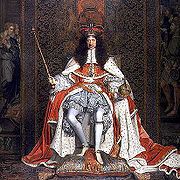
English Restoration
The Restoration of the English monarchy began in 1660 when the English, Scottish and Irish monarchies were all restored under Charles II after the Interregnum that followed the Wars of the Three Kingdoms...
of Charles II in 1660, Wright's Roman Catholicism became less of a handicap, due to the King's preference for religious toleration. Never a good businessman, Wright encountered some financial difficulties and King Charles granted him the privilege of disposing of his collection of old masters
Old Master
"Old Master" is a term for a European painter of skill who worked before about 1800, or a painting by such an artist. An "old master print" is an original print made by an artist in the same period...
by means of a lottery. The King himself acquired 14 of the paintings. By the early 1660s Wright had established a successful studio in London, and was described by diarist John Evelyn
John Evelyn
John Evelyn was an English writer, gardener and diarist.Evelyn's diaries or Memoirs are largely contemporaneous with those of the other noted diarist of the time, Samuel Pepys, and cast considerable light on the art, culture and politics of the time John Evelyn (31 October 1620 – 27 February...
as "the famous painter Mr Write". Later, the Great Plague of London
Great Plague of London
The Great Plague was a massive outbreak of disease in the Kingdom of England that killed an estimated 100,000 people, 20% of London's population. The disease is identified as bubonic plague, an infection by the bacterium Yersinia pestis, transmitted through a flea vector...
(1665) drove Wright out to countryside, where he painted at least three members of the Catholic family of Arundell of Wardour. Ironically, in the next year, the Great Fire of London
Great Fire of London
The Great Fire of London was a major conflagration that swept through the central parts of the English city of London, from Sunday, 2 September to Wednesday, 5 September 1666. The fire gutted the medieval City of London inside the old Roman City Wall...
(1666) was to be of benefit to him, when he received one of the City of London
City of London
The City of London is a small area within Greater London, England. It is the historic core of London around which the modern conurbation grew and has held city status since time immemorial. The City’s boundaries have remained almost unchanged since the Middle Ages, and it is now only a tiny part of...
's first new artistic commissions to paint twenty-two full length portraits of the so-called 'Fire Judges' (those appointed to assess the property disputes arising from the fire). These paintings, completed in 1670, hung in London's Guildhall
Guildhall, London
The Guildhall is a building in the City of London, off Gresham and Basinghall streets, in the wards of Bassishaw and Cheap. It has been used as a town hall for several hundred years, and is still the ceremonial and administrative centre of the City of London and its Corporation...
until it was bombed during World War II; today only two (those of Sir Matthew Hale
Matthew Hale (jurist)
Sir Matthew Hale SL was an influential English barrister, judge and jurist most noted for his treatise Historia Placitorum Coronæ, or The History of the Pleas of the Crown. Born to a barrister and his wife, who had both died by the time he was 5, Hale was raised by his father's relative, a strict...
and Sir Hugh Wyndham) remain in the Guildhall Art Gallery
Guildhall Art Gallery
The Guildhall Art Gallery houses the art collection of the City of London, England. It occupies a building that was completed in 1999 to replace an earlier building destroyed in The Blitz in 1941...
the remainder having been destroyed or dispersed.
Royal patronage

Patronage
Patronage is the support, encouragement, privilege, or financial aid that an organization or individual bestows to another. In the history of art, arts patronage refers to the support that kings or popes have provided to musicians, painters, and sculptors...
. In 1661, soon after the coronation, he painted a formalised portrait of the monarch, seated in front of a tapestry
Tapestry
Tapestry is a form of textile art, traditionally woven on a vertical loom, however it can also be woven on a floor loom as well. It is composed of two sets of interlaced threads, those running parallel to the length and those parallel to the width ; the warp threads are set up under tension on a...
representing the Judgement of Solomon, wearing St. Edward's Crown
St. Edward's Crown
St Edward's Crown was one of the English Crown Jewels and remains one of the senior British Crown Jewels, being the official coronation crown used in the coronation of first English, then British, and finally Commonwealth realms monarchs...
, the robes of the Garter
Order of the Garter
The Most Noble Order of the Garter, founded in 1348, is the highest order of chivalry, or knighthood, existing in England. The order is dedicated to the image and arms of St...
, and carrying the orb and sceptre. Wright was also commissioned to paint an allegorical ceiling for the King's bedchamber at Whitehall Palace, and he was further appointed in 1673 to the office of "picture drawer in ordinary", allowing him to exercise his right to sign his pictures "Pictor Regis". However, to his disappointment, he did not receive the coveted office of King's Painter, which was held in the 1660s by Sir Peter Lely
Peter Lely
Sir Peter Lely was a painter of Dutch origin, whose career was nearly all spent in England, where he became the dominant portrait painter to the court.-Life:...
alone. In contrast to Wright's sympathetic realism, and carefully observed landscape backgrounds, Lely had a more glamorous style, favoured by the court, and based on Van Dyck's pre-Civil War style. This prompted the diarist Samuel Pepys
Samuel Pepys
Samuel Pepys FRS, MP, JP, was an English naval administrator and Member of Parliament who is now most famous for the diary he kept for a decade while still a relatively young man...
to remark, after an enjoyable visit to Lely's studio, "thence to Wright's the painters: but Lord, the difference that is between their two works".
Unlike Lely, who was knighted, Wright never received significant recognition from King Charles. However, at least one admirer thought he did deserve it. In 1669, Wright and the miniaturist
Portrait miniature
A portrait miniature is a miniature portrait painting, usually executed in gouache, watercolour, or enamel.Portrait miniatures began to flourish in 16th century Europe and the art was practiced during the 17th century and 18th century...
Samuel Cooper
Samuel Cooper
Samuel Cooper was an English miniature painter, and younger brother of Alexander Cooper.He is believed to have been born in London, and was a nephew of John Hoskins, the miniature painter, by whom he was educated. He lived in Henrietta Street, Covent Garden, and frequented the Covent Garden...
had met Cosimo III de' Medici, Grand Duke of Tuscany
Cosimo III de' Medici, Grand Duke of Tuscany
Cosimo III de' Medici was the penultimate Medici Grand Duke of Tuscany. He reigned from 1670 to 1723, and was the elder son of Grand Duke Ferdinando II. Cosimo's 53-year long reign, the longest in Tuscan history, was marked by a series of ultra-reactionary laws which regulated prostitution and...
. Cosimo later called at Wright's studio where he commissioned a portrait of the Duke of Albemarle
George Monck, 1st Duke of Albemarle
George Monck, 1st Duke of Albemarle, KG was an English soldier and politician and a key figure in the restoration of Charles II.-Early life and career:...
from Wright. On March 3, 1673, perhaps some time after Wright had painted his state picture of Charles II (now in the Royal Collection), a strange letter was sent from an obscure "Mairie Lady Hermistan" (evidently a fellow Roman Catholic) to Cosimo, asking him to intercede with the King to grant Wright a baronetcy. However, nothing came of the request.
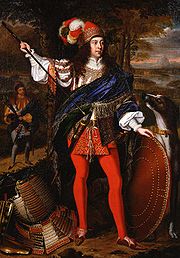
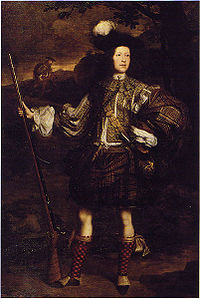
Sir Walter Bagot, 3rd Baronet
Sir Walter Bagot, 3rd Baronet , a barrister and landowner, succeeded to the title 3rd Baronet of Blithfield Hall, Staffordshire on the death of his father Sir Edward Bagot in 1673....
of Blithfield in Staffordshire in 1676/7. In 1678, he removed to Dublin for a number of years, perhaps due to the anti-Catholic hysteria generated by Titus Oates
Titus Oates
Titus Oates was an English perjurer who fabricated the "Popish Plot", a supposed Catholic conspiracy to kill King Charles II.-Early life:...
's Popish Plot
Popish Plot
The Popish Plot was a fictitious conspiracy concocted by Titus Oates that gripped England, Wales and Scotland in Anti-Catholic hysteria between 1678 and 1681. Oates alleged that there existed an extensive Catholic conspiracy to assassinate Charles II, accusations that led to the execution of at...
. Here, still styling himself "Pictor Regis", he painted "The Ladies Catherine and Charlotte Talbot", which is today in the National Gallery of Ireland
National Gallery of Ireland
The National Gallery of Ireland houses the Irish national collection of Irish and European art. It is located in the centre of Dublin with one entrance on Merrion Square, beside Leinster House, and another on Clare Street. It was founded in 1854 and opened its doors ten years later...
. He also painted two full-lengths portraits of costumed chieftains, the "Sir Neil O'Neil" (c. 1680), now in the Tate Collection, and the "Lord Mungo Murray" (c.1683), now in the Scottish National Portrait Gallery
Scottish National Portrait Gallery
The Scottish National Portrait Gallery is an art gallery on Queen Street, Edinburgh, Scotland. It holds the national collections of portraits, all of which are of, but not necessarily by, Scots. In addition it also holds the Scottish National Photography Collection...
. Sir Neil O’Neill was a fellow Roman Catholic, also in exile in Dublin. Wright portrayed him in the dress costume of an Irish chieftain, with suit of rare Japanese armour at his feet. The significance of this armour is that it is thought to be a coded symbol of a triumph over the persecutors of Roman Catholicism, of whom, at that time, the Japanese were notorious. The portrait of Mungo Murray (the 5th son of the Royalist Marquis of Atholl
John Murray, 1st Marquess of Atholl
John Murray, 1st Marquess of Atholl, KT was a leading Scottish royalist and defender of the Stuarts during the English Civil War of the 1640s, until after the rise to power of William and Mary in 1689...
) is notable for being considered one of the first instance of Scottish tartan
Tartan
Tartan is a pattern consisting of criss-crossed horizontal and vertical bands in multiple colours. Tartans originated in woven wool, but now they are made in many other materials. Tartan is particularly associated with Scotland. Scottish kilts almost always have tartan patterns...
being portrayed in art.
Roman embassy
In 1685, when the openly Roman Catholic James IIJames II of England
James II & VII was King of England and King of Ireland as James II and King of Scotland as James VII, from 6 February 1685. He was the last Catholic monarch to reign over the Kingdoms of England, Scotland, and Ireland...
ascended the throne, Wright was able to return to royal service. However, significantly, James did not employ Wright as an artist, but gave him the "time consuming and futile post" of steward on a diplomatic embassy. He was appointed as steward to Roger Palmer, 1st Earl of Castlemaine
Roger Palmer, 1st Earl of Castlemaine
Roger Palmer, 1st Earl of Castlemaine PC was an English courtier, diplomat, and politician who sat in the House of Commons in 1660. He was also a noted Catholic writer...
husband of Barbara Villiers
Barbara Palmer, 1st Duchess of Cleveland
Barbara Palmer, 1st Duchess of Cleveland was an English courtesan and perhaps the most notorious of the many mistresses of King Charles II of England, by whom she had five children, all of which were acknowledged and subsequently ennobled...
, the late King's mistress. Wright's knowledge of Rome and of the Italian language
Italian language
Italian is a Romance language spoken mainly in Europe: Italy, Switzerland, San Marino, Vatican City, by minorities in Malta, Monaco, Croatia, Slovenia, France, Libya, Eritrea, and Somalia, and by immigrant communities in the Americas and Australia...
may have played a part in this, as Castlemaine was dispatched, in 1686, on an embassy to Pope Innocent XI to demonstrate that England could become a player on the Roman Catholic side in impending European conflicts. Wright's role in the embassy was to oversee the production of elaborate coaches, costumes and decorations for the procession, which secured a papal audience in January 1687. He also arranged a stupendous banquet for a thousand guests in the Palazzo Doria Pamphilj, complete with sugar sculptures and a large state portrait of James II. While in Rome, Wright published an illustrated Italian account of the embassy, dedicated to the Duchess of Modena
Laura Martinozzi
Laura Martinozzi was a Duchess consort of Modena. On the death of her husband, she became the regent of the Duchy in the name of her son, Francesco.-Biography:...
and, on his return, an English version was published in October 1687, dedicated to her daughter Queen Mary
Mary of Modena
Mary of Modena was Queen consort of England, Scotland and Ireland as the second wife of King James II and VII. A devout Catholic, Mary became, in 1673, the second wife of James, Duke of York, who later succeeded his older brother Charles II as King James II...
.
Final years
Wright's career came to an end in 1688 with the expulsion of King James II during the Glorious RevolutionGlorious Revolution
The Glorious Revolution, also called the Revolution of 1688, is the overthrow of King James II of England by a union of English Parliamentarians with the Dutch stadtholder William III of Orange-Nassau...
. He seems to have accepted the inevitable end of his royal favour with the accession to the throne of the Protestant William of Orange
William III of England
William III & II was a sovereign Prince of Orange of the House of Orange-Nassau by birth. From 1672 he governed as Stadtholder William III of Orange over Holland, Zeeland, Utrecht, Guelders, and Overijssel of the Dutch Republic. From 1689 he reigned as William III over England and Ireland...
. He lived on, in relative poverty, for a further six years until 1694. In March of that year, he made a will leaving his house in St Paul's parish
St Paul's Cathedral
St Paul's Cathedral, London, is a Church of England cathedral and seat of the Bishop of London. Its dedication to Paul the Apostle dates back to the original church on this site, founded in AD 604. St Paul's sits at the top of Ludgate Hill, the highest point in the City of London, and is the mother...
to his niece Katherine Vaux. His collection of drawings, prints and books were left to his nephew, the painter Michael Wright; however a codicil to the will stated that the books were to be sold on behalf of his son Thomas, who was then abroad. The books were auctioned on June 4 and on August 1, 1694, John Michael Wright was buried at St Martin-in-the-Fields
St Martin-in-the-Fields
St Martin-in-the-Fields is an Anglican church at the north-east corner of Trafalgar Square in the City of Westminster, London. Its patron is Saint Martin of Tours.-Roman era:Excavations at the site in 2006 led to the discovery of a grave dated about 410...
.
Artistic legacy
Much of the scholarly appreciation of Wright's work is fairly recent. In 1982, an exhibition of his work: ‘John Michael Wright – The King’s Painter’ – in the Scottish National Portrait GalleryScottish National Portrait Gallery
The Scottish National Portrait Gallery is an art gallery on Queen Street, Edinburgh, Scotland. It holds the national collections of portraits, all of which are of, but not necessarily by, Scots. In addition it also holds the Scottish National Photography Collection...
– led to a renewed interest in his contributions, and the catalogue (edited by Sara Stevenson and Duncan Thomson) re-wrote and uncovered much of the known biographical details. New works continue to be discovered and previously known ones re-attributed to him. Wright is now viewed as amongst the most successful of seventeenth-century Britain's indigenous artists, and is rated alongside contemporaries such as Robert Walker
Robert Walker (painter)
Robert Walker was an English portrait painter, notable for his portraits of the "Lord Protector" Oliver Cromwell and other distinguished parliamentarians of the period...
and William Dobson
William Dobson
William Dobson was a portraitist and one of the first notable English painters, praised by his contemporary John Aubrey as "the most excellent painter that England has yet bred"....
. One modern exhibition catalogue described him as "the finest seventeenth century British-born painter". Certainly, he was one of the few who painted the elite aristocracy of his day, and was responsible for some of the most magnificent royal portraiture surviving. This achievement is particularly significant in an age where even British patrons had tended to favour foreign artists like Holbein
Hans Holbein the Younger
Hans Holbein the Younger was a German artist and printmaker who worked in a Northern Renaissance style. He is best known as one of the greatest portraitists of the 16th century. He also produced religious art, satire and Reformation propaganda, and made a significant contribution to the history...
and Van Dyck
Anthony van Dyck
Sir Anthony van Dyck was a Flemish Baroque artist who became the leading court painter in England. He is most famous for his portraits of Charles I of England and his family and court, painted with a relaxed elegance that was to be the dominant influence on English portrait-painting for the next...
, and would continue to favour immigrants such as Lely and Kneller
Godfrey Kneller
Sir Godfrey Kneller, 1st Baronet was the leading portrait painter in England during the late 17th and early 18th centuries, and was court painter to British monarchs from Charles II to George I...
. Indeed, part of the reason for Wright’s success is recognised as being his unusually cosmopolitan training: no prior British artist had so much exposure to European influence. During his Italian sojourn, and his participation in the Accademia di San Luca
Accademia di San Luca
The Accademia di San Luca, was founded in 1577 as an association of artists in Rome, under the directorship of Federico Zuccari, with the purpose of elevating the work of "artists", which included painters, sculptors and architects, above that of mere craftsmen. Other founders included Girolamo...
, not only had Wright collected works attributed to continental giants like Michelangelo, Raphael and Titian, he had also been influenced by, and even copied, much of their tone and style.
,_duchess_of_cleveland_by_john_michael_wright.jpg) |
.jpg) |
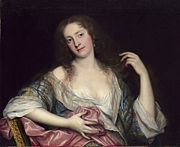
Art critic
An art critic is a person who specializes in evaluating art. Their written critiques, or reviews, are published in newspapers, magazines, books and on web sites...
, Millar, observes that any comparisons undertaken would "ruthlessly expose Wright's weaknesses and mannerisms" but that positively "they would also demonstrate his remarkable independence, his unfailing integrity and charm, the sources of which must partly lie in his unusual origins, fragmented career and attractive personality". Millar suggests that a particularly useful comparison can be made between Lely and Wright's respective portrayals of the Duchess of Clevland (Barbara Villiers) (above). Whereas Lely portrayed her as a "full-blown and palpably desirable strumpet", the more seriously-minded Wright, who was not really in sympathy with the morality of the new court and its courtesans, rendered a more puppet-like figure.
However, even if Lely was considered the more masterly and fashionable of the two in seventeenth-century Britain, Wright is generally accepted as portraying the more lively and realistic likenesses of his subjects, a fact that reinforces Pepys’s observation that Lely’s work was "good but not like". Neither should Wright's realism be confused with a prudishness; as can be seen, for example, in his portrait the lady, thought to be Ann Davis (right). The picture, with the sitter's clothing left undone and her modesty barely preserved by a red drape, has been described as exhibiting a fresh – even risky – reality: erotic by contemporary standards. Whereas Wright's contemporaries might have used the ‘disguise’ of presenting the sitter in the guise of a classical goddess to protect against accusation of salaciousness, Wright's portrait rather depends on his realism, notably in his flesh tones, and depth.
External links
- John Michael Wright at the National Portrait Gallery, London
- John Michael Wright at the Royal CollectionRoyal CollectionThe Royal Collection is the art collection of the British Royal Family. It is property of the monarch as sovereign, but is held in trust for her successors and the nation. It contains over 7,000 paintings, 40,000 watercolours and drawings, and about 150,000 old master prints, as well as historical...
- John Michael Wright at the Tate Collection
- John Michael Wright at the National Galleries of ScotlandNational Galleries of ScotlandThe National Galleries of Scotland are the five national galleries of Scotland and two partner galleries. It is one of the country's National Collections.-List of national galleries:* The National Gallery of Scotland* The Royal Scottish Academy Building...

